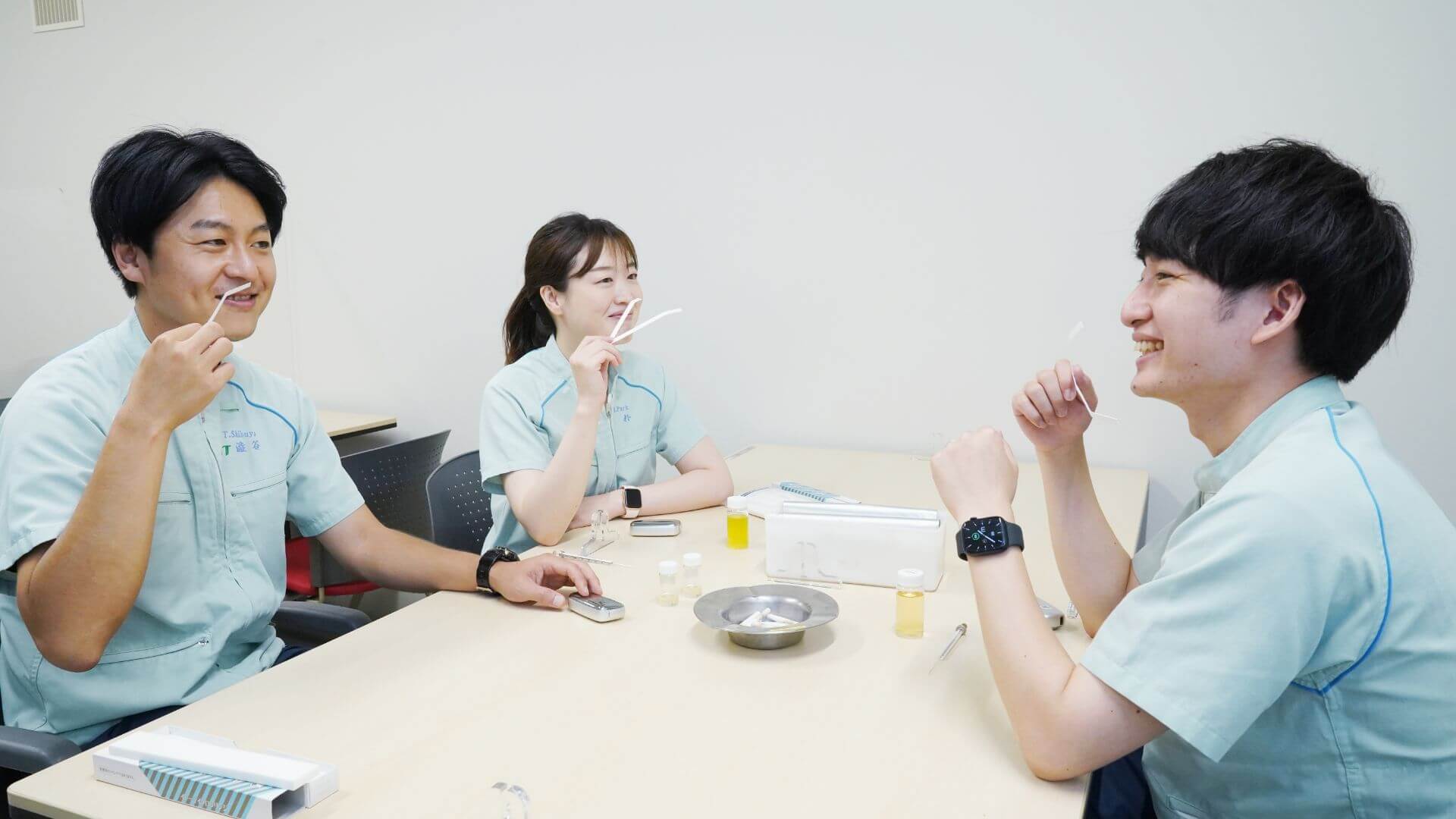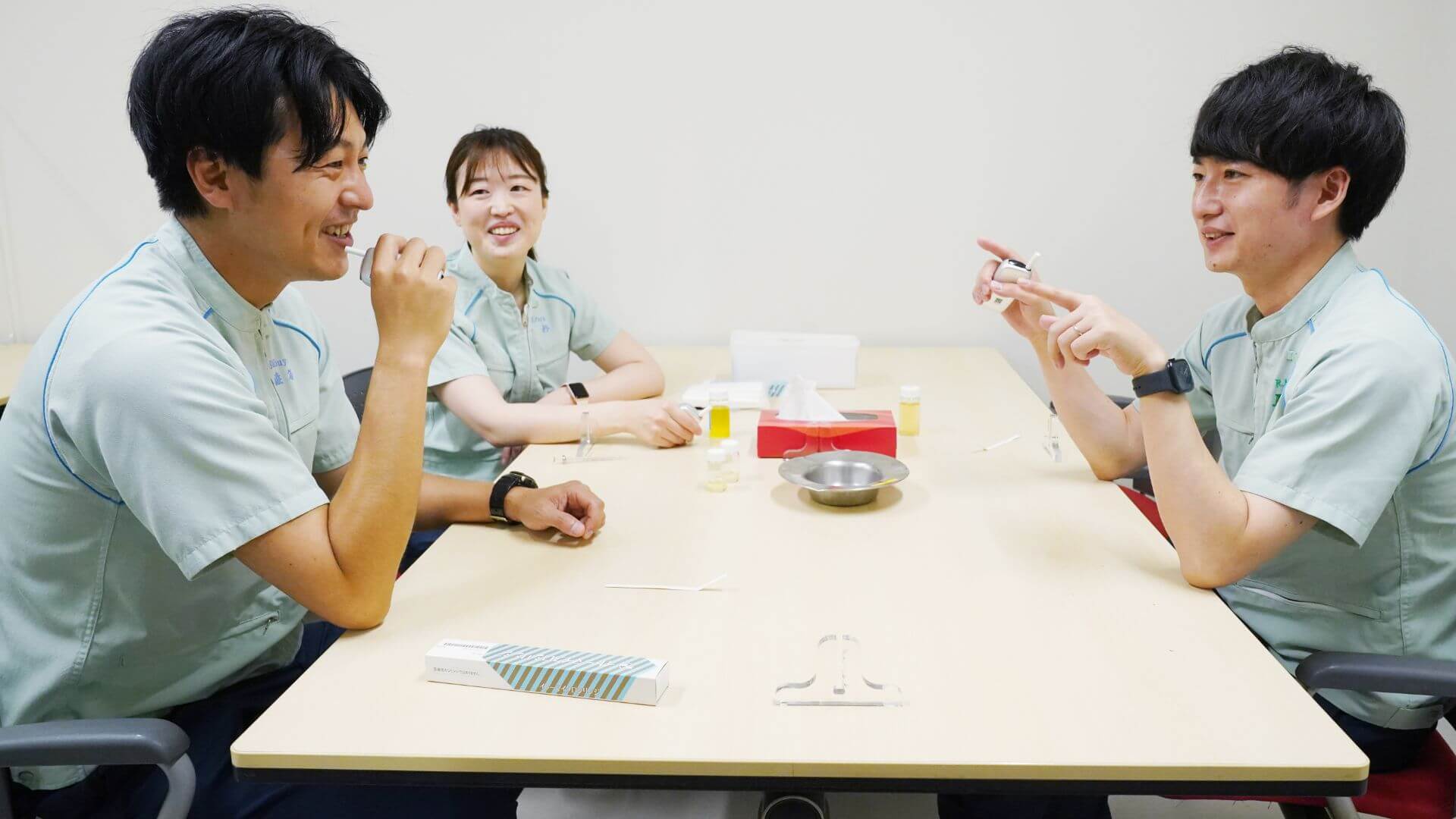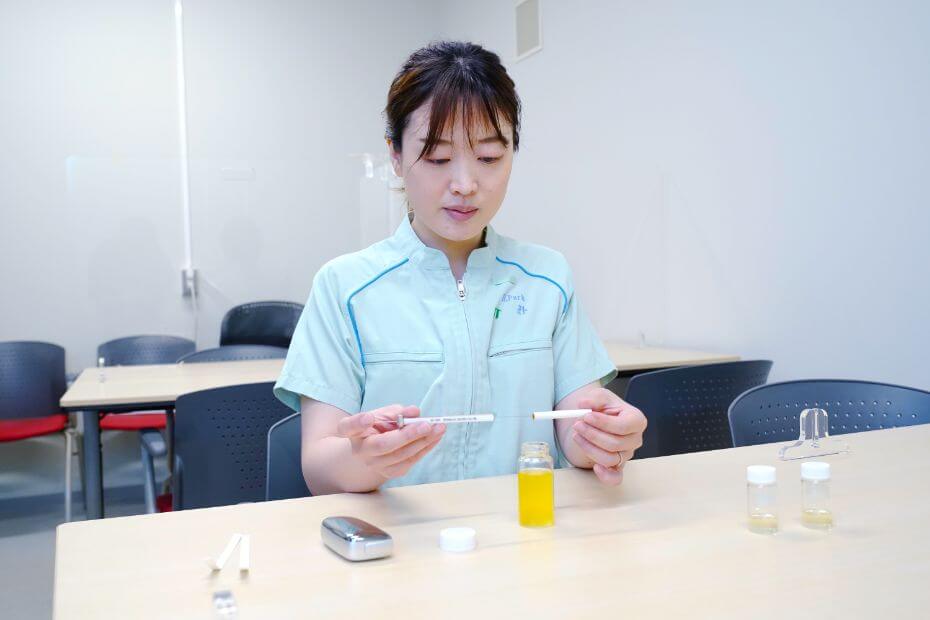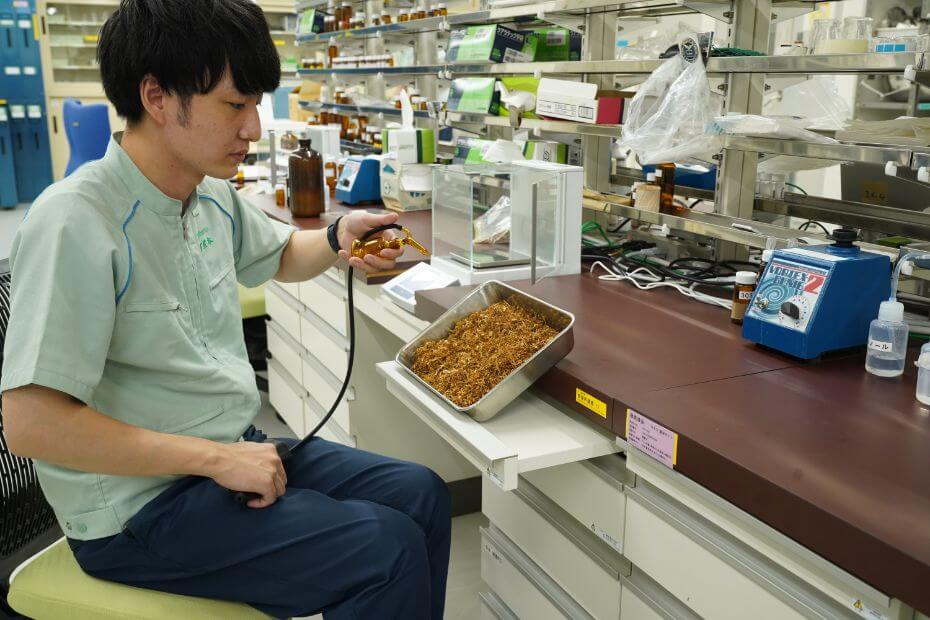Dialogue with blenders
#07 CROSS TALK
Combining flavor ingredients to enrich tobacco products’ flavor,
work known as “flavor mixing”

“Flavor mixing” is work that consists of creating flavors by combining substances known as flavoring ingredients, to create the character of each tobacco product brand. Since their fine balance can greatly affect the tastes and flavors of tobacco products, flavorists are both careful and bold when preparing their recipes.
MEMBER
-
 Technology Development
Technology DevelopmentRyosuke Muromoto
Responsible for development and maintenance of flavors for tobacco products.
-
 Technology Development
Technology DevelopmentTeturo Shibuya
Responsible for development of flavors for heated tobacco sticks.
-
 Technology Development
Technology DevelopmentHalim Park
Responsible for development of flavors for heated tobacco sticks.
What kind of work is “flavor mixing”? Please tell us about the content and procedures of this work.

Combining flavoring ingredients with types that number in the hundreds, to create flavors that become the character of tobacco products
-

Muromoto -

Shibuya There are many types of flavoring ingredients including those extracted from plants such as herbs as well as synthetic types, and we usually use from 300 to 400 types in our work alone.
-

Muromoto To keep track, the incense elements are numbered, but some are in the 500s, so there may actually be more.They vary in liquid and powder, viscosity and color.
-

Park Flavoring ingredients have a wide variety of flavors, but by combining them, unique flavors can be made in many variations.
-

Shibuya They will differ depending on the types of flavoring ingredients that are combined as well as their amounts, so it is no exaggeration to say that infinite combinations are possible.
-

Muromoto The world of flavor mixing work has very deep and interesting aspects. For example, there are some flavoring ingredients that give a fruity flavor if added in small amounts but have a smell like sulfur in large amounts.
-

Shibuya The role of flavor mixing in tobacco creation is also very broad, since there are an infinite number of combinations that can be created. In addition to giving distinctiveness to brands, we also receive various requests from members who are working on development projects with us, such as “Can you make it less strong?” and “Can you have it produce a certain amount of smoke?”, so we respond to them as if we were a “jack-of-all-trades.“
-

Muromoto Some things can only be accomplished by flavor mixing, so there are many instances where I feel we are being relied on by other responsible personnel.
-

Park Yes, that’s true. Flavors not only control the quality of flavor sensations, but also enrich the taste of tobacco leaves and change the quality of smoke, so flavor mixing has the role of supporting the tastes and flavors of tobacco aside from just creating flavors.
-

Muromoto In the process of developing new products such as cigarettes and RRP*, orders are first received by our department from the personnel responsible for organizing projects. We may meet with product planners and marketing representatives to discuss the details of the order, such as the concept of the new product and what kind of flavor is required.
*Reduced-Risk Products: Products with the potential to reduce the health risks associated with smoking
-

Shibuya The people responsible for flavor mixing gain an image of the flavor that is suitable for the concept of the requested product, formulate the flavoring ingredients, and investigate the recipe.
-

Park In this process, several prototypes are created. The tastes and flavors are checked by injecting the formulated flavor into an unflavored stick with a syringe, or by spraying it on tobacco leaves for testing (test smoking, actually smoking the prototype to check the taste and flavor, etc.). The process of creating and testing the flavor again is repeated many times while determining what is insufficient for the order, and identifying fine differences in tastes and flavor. The flow of work is that at first only the members of the flavor mixing team perform tests, but when it becomes more complete, the project members are also asked to test it and share their opinions, and further improvements are then made.
-

Shibuya The team for leaf blending, which is responsible for blending tobacco leaves, is located on the same floor as our team, so when we want to consult with them for a bit or ask questions, we can go there right away.
-

Muromoto We proceed with work on both RRP* and cigarettes in collaboration with members of the leaf blending team, but the impression is not quite as formal to really be called “collaboration.” It is more like a friendly relationship where we can just drop by each other’s desks to chat.
*Reduced-Risk Products: Products with the potential to reduce the health risks associated with smoking
-

Shibuya When tests are performed by personnel responsible for work other than flavor mixing, such as leaf blending, various opinions are received which are very useful in making improvements.
-

Muromoto We refer to new flavor recipes developed in this way as “mixing standards,” and they are stored in a database and kept in locked storage.


Maintenance to maintain consistency of tastes and flavors
-

Muromoto Meanwhile, maintenance work is conducted to maintain the tastes and flavors of products which are already being sold. The flavor of each brand is stored as a recipe, but if regulations related to tobacco products are revised or the supply status of flavoring ingredients changes, it may not be possible to create the same flavor as in the initial recipe. For this reason, the initial recipe is kept as a reference and recipes are adjusted to preserve the same tastes and flavors from before. This is what is involved in the work known as maintenance.
-

Park For RRP*, changes to the devices used to heat sticks may cause the heating temperature to also change, so maintenance will be required. The heating temperature has a large impact on how flavors are expressed. Therefore, we carry out maintenance of flavors together with the development of devices.
*Reduced-Risk Products: Products with the potential to reduce the health risks associated with smoking
-

Shibuya In addition, if there are revisions to material standards such as the size of filters for sticks, the flavor will also change slightly which will make maintenance necessary.
-

Muromoto Personnel responsible for flavor mixing consider not only the flavor characteristics of flavoring ingredients themselves, but also how they are expressed when they are heated and how their properties change with temperature. In the case of the cigarette product that I am responsible for, I need to understand what kind of flavor is released at the combustion temperature, which is about 700 degrees. Heated tobacco products (hereafter HTP), on the other hand, have different difficulties from cigarettes because their heating temperatures vary depending on the device.
-

Shibuya Cigarettes and HTP are completely different. Each flavoring ingredient has its own temperature at which it vaporizes. For example, if a device has a heating temperature of 200 degrees, we create a flavor that combines flavoring ingredients suitable for that temperature. If the temperature changes to 300 degrees, it will become necessary to choose other flavoring ingredients which match that temperature. If an ingredient for 200 degrees is used without changing it, it may vaporize too quickly and its taste may become weaker and weaker, so we adjust the flavor allowing it to be enjoyed until the end.
-

Muromoto It is also important to understand changes in materials and leaf blending, which will make flavor maintenance necessary if the device has changed as well.
At what times do you find the work of flavor mixing most interesting and rewarding?

The appeal of flavor mixing is that there is no one “correct” flavor to be created
-

Shibuya As I also mentioned before, the most interesting part of flavor mixing work is that an almost limitless number of tastes and flavors can be expressed, depending on combinations of the more than 300 to 400 types of flavoring ingredients, and the amounts of each of them that are used. Even if you use an incorrect amount of a flavoring ingredient when creating a recipe, it often produces an unexpectedly pleasing flavor. Small mistakes often lead to new discoveries.
-

Park I am pleased when I can respond well to a request for creating a flavor. This is even more true when, rather than just fulfilling the task that has been given, the person who made the request offers words of encouragement, such as “This has an excellent flavor” or “I didn’t know you could make a flavor like this.” The fact that there is no single correct answer is also very interesting in flavor mixing. If we are creating a flavor of bananas, for example, the one I make will be different from the ones made by Shibuya and Muromoto. It is not that one of them is “correct,” but instead all of them are good flavors with their own individualities.
-

Muromoto There is no one right answer, but ultimately, a decision has to be made on which flavor to use. Prototypes of the candidate flavors are lined up and decisions are made in testing meetings with the project members. However, if it is difficult to decide which is better, we may conduct a consumer survey and make a judgment based on the results.
-

Shibuya Consumer surveys are conducted according to scores based on likes and dislikes, but there are cases where instead of products with high average scores, products whose results are largely divided between high and low scores are adopted. I have heard that in the past, a product using flavor capsules which was released for sale had an extremely divided evaluation of likes and dislikes.
-

Muromoto It is true that like that example, the opinions of some flavors are sharply separated. Looking at the market, there are some flavor types which we can definitely identify as being popular, but I believe it is also important to make attempts with flavors that have never been seen before. We develop products with consumers in mind, but it is not an easy matter to predict what products will sell well.
-

Shibuya Even if you may think it has an excellent flavor yourself, that has no meaning unless consumers also think the same. Flavor creation inevitably reflects the personality of the creator. Developing a flavor while imagining the pleased reactions of consumers is both a difficult and rewarding part of flavor mixing work.


A special sense of achievement when a product is released into the world
-

Muromoto Park previously mentioned that there is no one correct answer for creating a banana flavor, but what I find difficult in flavor mixing is to connect sensory impressions to language. There are countless words to describe flavors, such as “nutty,” “fruity,” “floral,” or “sweet.” During my training as a new employee, I smelled all of our flavoring ingredients from number 1 to 500 and went through training to describe their flavors in words, but even now when doing my work I feel the difficulty as well as importance of accurately understanding the expressions of other members and conveying my own feelings. In my daily work as well, I not only keep conscious of how to express myself, but am aware of the differences in my sensations compared to other people and try to make sure that no communication errors occur.
-

Shibuya It is difficult not only to just create a “banana flavor” and gain a mutual understanding of its characteristics with other people through words, but also to create it while thinking about matching the completed “banana flavor” with the true flavor of tobacco leaves.
-

Muromoto Yes, that's right. Flavors themselves are different from the tastes and flavors that result after they are added to tobacco products. It is because I have repeated these struggles that I feel an even greater sense of accomplishment when a product I have been involved with is released to the world. In some cases some development projects may require several years from the start of development until market launch, but even if such a project is passed down from me to someone else, I will feel more than enough of a sense of accomplishment from it.
What do you consider important in the work of flavor mixing?

The important points are a sense of chance, a playful spirit, the mindset of adding something extra, and sensitivity
-

Shibuya When creating a flavor recipe, if for example I want to strengthen the sweetness of the flavor, I sometimes deliberately add double or triple the amount of sweet flavoring ingredients. Then, when I taste it even while worrying if it is too sweet, in more than a few cases it will have a surprisingly good flavor. By not making a fixed decision myself on what is the “right amount,” and instead mixing in an amount that is more than expected, I also place importance on the sense of chance in my work to create a flavor that goes beyond my own perceptions.
-

Park This attitude may also be described as having a playful spirit when working, without being bound by stereotypes. By respecting the playfulness of not only myself but also the people around me, I feel like I can encounter “serendipity.”
-

Muromoto Working with a playful spirit will also make it easier to bring forth ideas that are unique to yourself. In addition to the flavors that were ordered, I also make it a point to suggest flavors that I have devised in my own way while referring to past knowledge, as a way of adding something extra, with suggestions such as, “I also tried making this kind of flavor, but what do you think of it?” I am very happy when such proposals are accepted.
-

Park In flavor mixing work, it is important to have rich and strong sensitivity that is not influenced by others. To nurture my sensitivity, I try to participate in communities where I can meet different people outside of my workplace. I feel like I can be inspired and think more flexibly by coming into contact with people who have different ways of thinking. Also, when I go out to eat, I try to select food that I have never eaten before or food which I don't usually order. I enjoy experiencing the flavors of food that I have never seen before, and the new sensations of “I never knew there were flavors like this.” Even when I shop at a supermarket, if I see something new for sale like “melon-flavored beer,” I try buying and drinking it to see what its taste and flavor are like for myself. Experiences like these can lead to the birth of new ideas.
-

Shibuya Yes they can, can’t they? I usually stay on the lookout for new things too. If I see a product with a new flavor, I check the flavor first of all. Sometimes it can spark a new idea and can be very useful when thinking of a recipe.
-

Park Health management is also a crucial point. Good performance in flavor mixing work is usually achieved when I am feeling physically well myself. If I don't feel well, I can't enjoy good food either.
-

Muromoto I agree!
-

Shibuya So do I!


Future challenges we want to make in flavor mixing work
-

Muromoto I believe this is a goal of anyone involved in flavor mixing, but I want to create a hit tobacco product which has a taste I created myself. The first tobacco product I felt had a really good taste when I smoked it was the JT Group’s cigarettes with a blueberry flavor, and that taste attracted me to join the company. After entering, I was assigned to the flavor mixing team, and I was overjoyed to start my work under senior colleague who had created that tobacco flavor. My personal challenge is to create such a taste that will remain in the hearts and memories of people, and to have it be enjoyed by many consumers. Flavor creation is said to be like master craftsmanship, but I believe it is also necessary to create mechanisms that can allow delicious tobacco tastes and flavors to be created even without a high level of experience. By converting the characteristics of flavors into data and mapping them, we are attempting to digitize flavor data so that even those who do not yet have master-level skill can propose new flavors.
-

Shibuya I am considering and exploring the possibility of whether there may be combinations of flavors that affect the “somatosensory system,” or in other words, senses other than taste and smell which include the senses of touch, pain, and temperature. For example, when you smoke a strong menthol product, you may feel the stimulation from the menthol in your mouth and have a bitter sensation, but if it is combined with other flavors, it changes to a sense of cold deep within the throat. I would like to do research that focuses on such methods of perceiving flavors.
-

Park I want to change the impression of HTP. Some people who smoke cigarettes may not be familiar with flavored types that have a relatively strong flavor. As the popularity of HTP and E-Vapor increases, we are working with the hopes of establishing flavored-type tobacco products as a separate category. I would be very happy if, by spreading a way of enjoying these products that has not been seen before, namely finding a flavor to your own liking from many different varieties, the choices for tobacco products could be expanded and the image and attitude toward tobacco could be changed even slightly.

Summary
Flavors cannot be seen with the eye, but play a critical role in enhancing the impression of each brand. The work known as “flavor mixing” involves creating combinations from hundreds of different flavoring ingredients to produce new flavors. With no single correct answer, this creation of new flavors while making full use of individual sensitivities is like the work of master artists.
*This section is intended only to explain the business operations of the JT Group, not to promote sales of tobacco products or encourage smoking among consumers.
In one phrase, this is work to create flavors which are added to cigarettes and RRP*. Flavors are made by mixing together multiple materials known as flavoring ingredients, while considering the balance of their types and quantities.
*Reduced-Risk Products: Products with the potential to reduce the health risks associated with smoking